oil FIAT DUCATO 244 2005 3.G Owners Manual
[x] Cancel search | Manufacturer: FIAT, Model Year: 2005, Model line: DUCATO 244, Model: FIAT DUCATO 244 2005 3.GPages: 258, PDF Size: 4.05 MB
Page 11 of 258
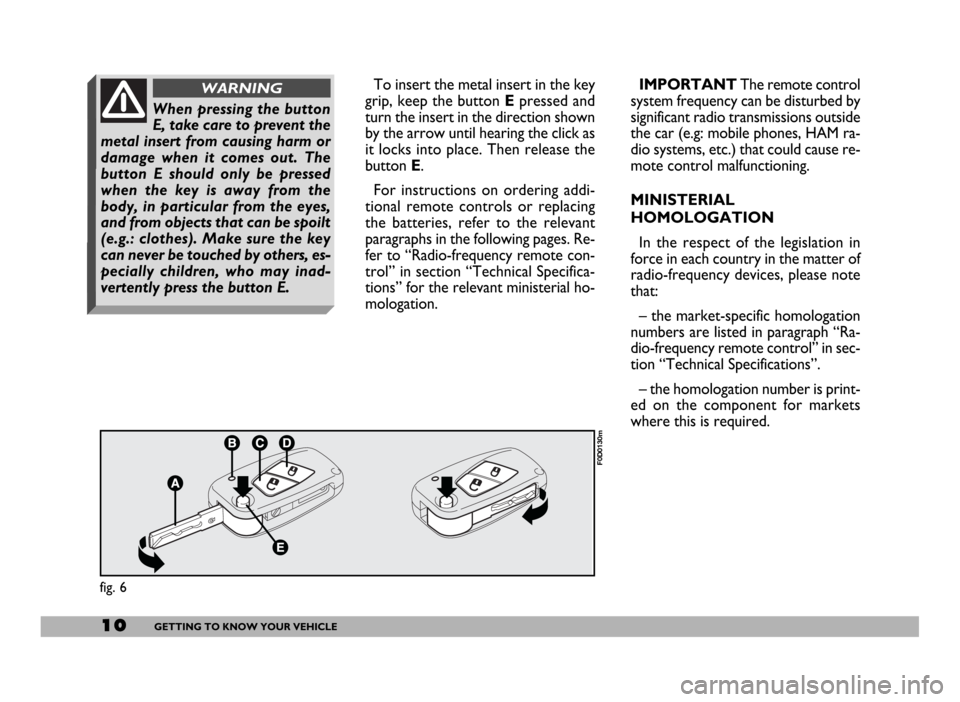
10GETTING TO KNOW YOUR VEHICLE
IMPORTANTThe remote control
system frequency can be disturbed by
significant radio transmissions outside
the car (e.g: mobile phones, HAM ra-
dio systems, etc.) that could cause re-
mote control malfunctioning.
MINISTERIAL
HOMOLOGATION
In the respect of the legislation in
force in each country in the matter of
radio-frequency devices, please note
that:
– the market-specific homologation
numbers are listed in paragraph “Ra-
dio-frequency remote control” in sec-
tion “Technical Specifications”.
– the homologation number is print-
ed on the component for markets
where this is required.
fig. 6
F0D0130m
To insert the metal insert in the key
grip, keep the button Epressed and
turn the insert in the direction shown
by the arrow until hearing the click as
it locks into place. Then release the
button E.
For instructions on ordering addi-
tional remote controls or replacing
the batteries, refer to the relevant
paragraphs in the following pages. Re-
fer to “Radio-frequency remote con-
trol” in section “Technical Specifica-
tions” for the relevant ministerial ho-
mologation.
When pressing the button
E, take care to prevent the
metal insert from causing harm or
damage when it comes out. The
button E should only be pressed
when the key is away from the
body, in particular from the eyes,
and from objects that can be spoilt
(e.g.: clothes). Make sure the key
can never be touched by others, es-
pecially children, who may inad-
vertently press the button E.
WARNING
Page 33 of 258

32GETTING TO KNOW YOUR VEHICLE
fig. 39
F0D0217m
ENGINE OIL LEVEL GAUGE
(where provided)
The gauge graphically displays the en-
gine oil level between the MINand
MAXreference points.
To perform measurement ensure
the vehicle is on a flat ground, then
proceed as follows:
1)when the engine is not running,
turn the ignition key to MAR;
2)the word “OIL” will be displayed
for 5 seconds together with six dashes
and five or six boxes showing the cor-
rect engine oil level;
Fig. 38- Correct oil level.
Fig. 39- Minimum oil level.
Should oil level be at minimum, re-
store oil level to the correct level as
soon as possible. Anyhow, before top-
ping up, first use the special dipstick
to check the level.
3)If the words “OIL HIGH”fig. 40
are displayed, this means that oil level
is excessive (over maximum level) and
it is therefore necessary to reduce its
level in the sump. DIGITAL CLOCK fig. 37
Clock can always be adjusted (also
with engine off and key removed).
Setting time
The clock will advance by one unit
each time the button G-fig. 37is
pressed. Press the button and hold it
down for a few seconds to rapidly ad-
vance the time automatically.
When the clock draws near to the
correct time, release the button and
complete the regulation manually.
fig. 37
F0D0154m
fig. 38
F0D0254m
fig. 40
F0D0215m
Page 37 of 258
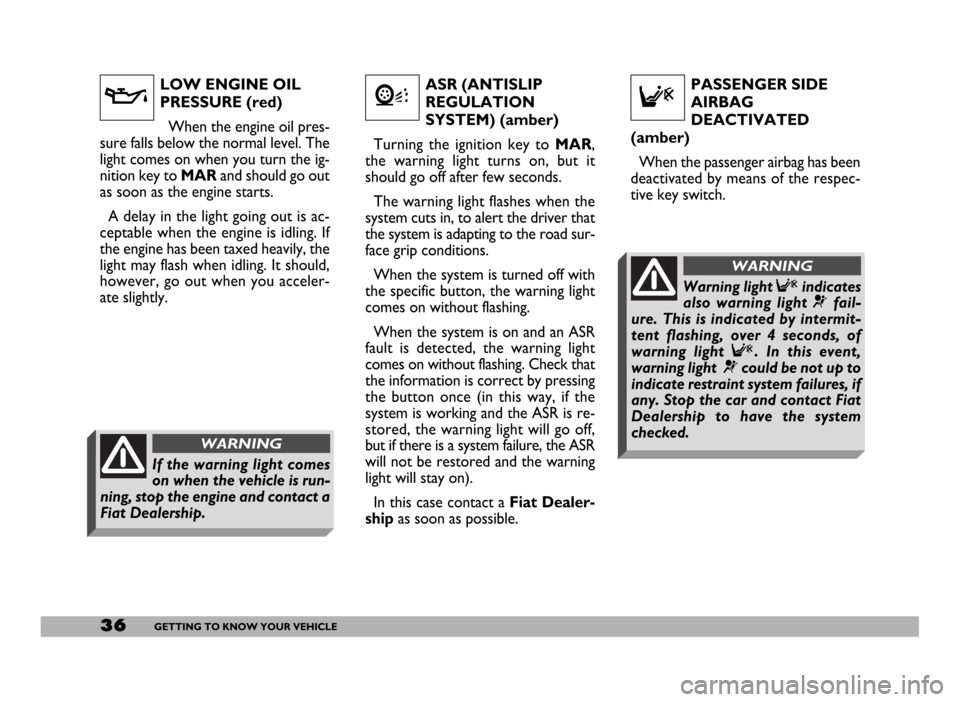
36GETTING TO KNOW YOUR VEHICLE
LOW ENGINE OIL
PRESSURE (red)
When the engine oil pres-
sure falls below the normal level. The
light comes on when you turn the ig-
nition key to MARand should go out
as soon as the engine starts.
A delay in the light going out is ac-
ceptable when the engine is idling. If
the engine has been taxed heavily, the
light may flash when idling. It should,
however, go out when you acceler-
ate slightly.vASR (ANTISLIP
REGULATION
SYSTEM) (amber)
Turning the ignition key to MAR,
the warning light turns on, but it
should go off after few seconds.
The warning light flashes when the
system cuts in, to alert the driver that
the system is adapting to the road sur-
face grip conditions.
When the system is turned off with
the specific button, the warning light
comes on without flashing.
When the system is on and an ASR
fault is detected, the warning light
comes on without flashing. Check that
the information is correct by pressing
the button once (in this way, if the
system is working and the ASR is re-
stored, the warning light will go off,
but if there is a system failure, the ASR
will not be restored and the warning
light will stay on).
In this case contact a Fiat Dealer-
shipas soon as possible.PASSENGER SIDE
AIRBAG
DEACTIVATED
(amber)
When the passenger airbag has been
deactivated by means of the respec-
tive key switch.
FV
If the warning light comes
on when the vehicle is run-
ning, stop the engine and contact a
Fiat Dealership.
WARNING
Warning light Findicates
also warning light ¬fail-
ure. This is indicated by intermit-
tent flashing, over 4 seconds, of
warning light F. In this event,
warning light ¬could be not up to
indicate restraint system failures, if
any. Stop the car and contact Fiat
Dealership to have the system
checked.
WARNING
Page 39 of 258
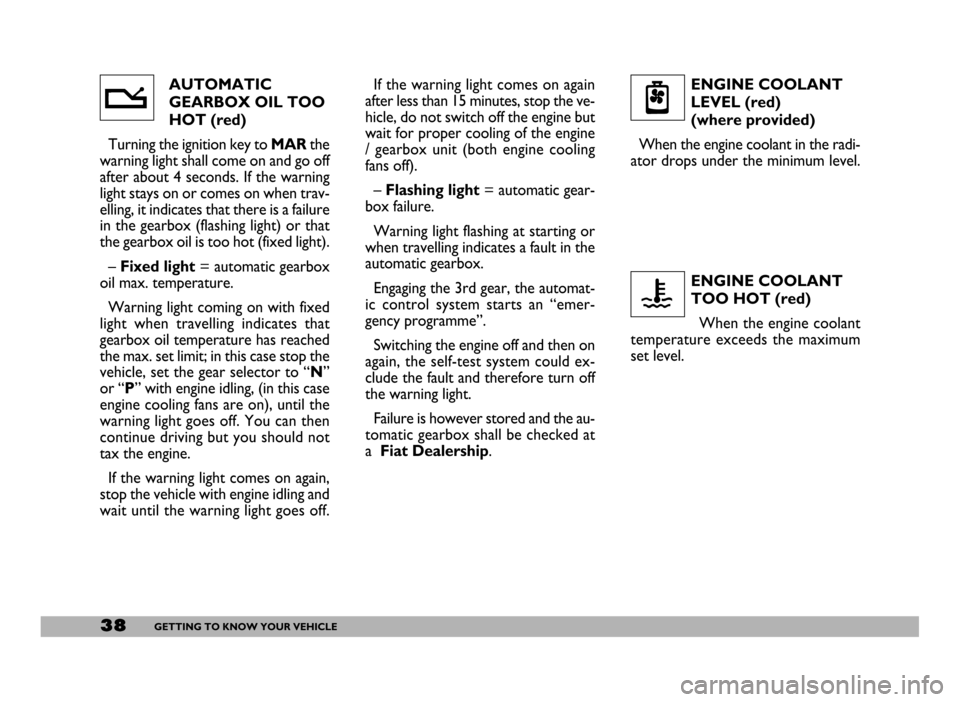
38GETTING TO KNOW YOUR VEHICLE
ENGINE COOLANT
LEVEL (red)
(where provided)
When the engine coolant in the radi-
ator drops under the minimum level.
n
AUTOMATIC
GEARBOX OIL TOO
HOT (red)
Turning the ignition key to MARthe
warning light shall come on and go off
after about 4 seconds. If the warning
light stays on or comes on when trav-
elling, it indicates that there is a failure
in the gearbox (flashing light) or that
the gearbox oil is too hot (fixed light).
– Fixed light= automatic gearbox
oil max. temperature.
Warning light coming on with fixed
light when travelling indicates that
gearbox oil temperature has reached
the max. set limit; in this case stop the
vehicle, set the gear selector to “N”
or “P” with engine idling, (in this case
engine cooling fans are on), until the
warning light goes off. You can then
continue driving but you should not
tax the engine.
If the warning light comes on again,
stop the vehicle with engine idling and
wait until the warning light goes off.If the warning light comes on again
after less than 15 minutes, stop the ve-
hicle, do not switch off the engine but
wait for proper cooling of the engine
/ gearbox unit (both engine cooling
fans off).
– Flashing light= automatic gear-
box failure.
Warning light flashing at starting or
when travelling indicates a fault in the
automatic gearbox.
Engaging the 3rd gear, the automat-
ic control system starts an “emer-
gency programme”.
Switching the engine off and then on
again, the self-test system could ex-
clude the fault and therefore turn off
the warning light.
Failure is however stored and the au-
tomatic gearbox shall be checked at
a Fiat Dealership.ENGINE COOLANT
TOO HOT (red)
When the engine coolant
temperature exceeds the maximum
set level.
u
t
Page 94 of 258

93GETTING TO KNOW YOUR VEHICLE
In the event of low speed side colli-
sions (for which seat belts are suffi-
cient protection), the airbag is not trig-
gered. Also in this case, it is important
to wear seat belts at all times. This will
ensure correct positioning of the pas-
senger and prevent being projected
from the vehicle in the event of very
violent crashes.
The side bag (driver and passenger)
is therefore not a replacement of but
is complementary to the use of belts,
which should always be worn, as spec-
ified by law in Europe and most non-
European countries.GENERAL WARNINGS
The front and/or side airbags
may be deployed if the vehicle is
subject to heavy knocks or acci-
dents involving the underbody
area, such as for example violent
shocks against steps, kerbs or low
obstacles, falling of the vehicle in
big holes or sags in the road.
Triggering of the airbags re-
leases a small amount of powder.
This powder is not harmful and
does not indicate the start of fire.
The unfold cushion surface and
the vehicle interiors could be cov-
ered by dusty remains: this dust
could irritate skin and eyes. In
case of contact, wash yourself us-
ing neutral soap and water.The airbag system has a validity
of 14 years as to the pyrotechnic
charge and 10 years as to the coil
contact (see the plate set on the
left front door post near hinges).
As these dates approach, con-
tact Fiat Dealership for replace-
ment.
If an accident has triggered the
airbag, contact a Fiat Dealership
so that the whole safety device,
electronic control unit, belt, pre-
tensioners can be replaced and
have the electric system checked
over.
All control, repair and replace-
ment operations concerning the
airbags must only be carried out
at a Fiat Dealership.
If you are having the vehicle
scrapped, have the airbag system
deactivated at a Fiat Dealership
first.
Page 108 of 258
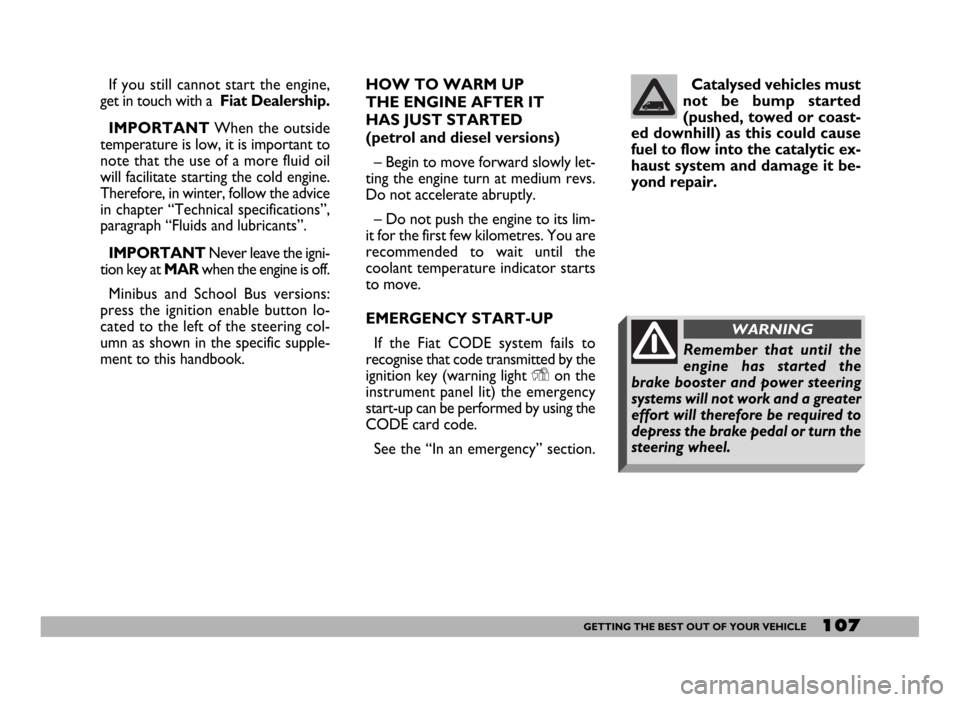
107GETTING THE BEST OUT OF YOUR VEHICLE
If you still cannot start the engine,
get in touch with a Fiat Dealership.
IMPORTANT When the outside
temperature is low, it is important to
note that the use of a more fluid oil
will facilitate starting the cold engine.
Therefore, in winter, follow the advice
in chapter “Technical specifications”,
paragraph “Fluids and lubricants”.
IMPORTANTNever leave the igni-
tion key at MARwhen the engine is off.
Minibus and School Bus versions:
press the ignition enable button lo-
cated to the left of the steering col-
umn as shown in the specific supple-
ment to this handbook.HOW TO WARM UP
THE ENGINE AFTER IT
HAS JUST STARTED
(petrol and diesel versions)
– Begin to move forward slowly let-
ting the engine turn at medium revs.
Do not accelerate abruptly.
– Do not push the engine to its lim-
it for the first few kilometres. You are
recommended to wait until the
coolant temperature indicator starts
to move.
EMERGENCY START-UP
If the Fiat CODE system fails to
recognise that code transmitted by the
ignition key (warning light Yon the
instrument panel lit) the emergency
start-up can be performed by using the
CODE card code.
See the “In an emergency” section.Catalysed vehicles must
not be bump started
(pushed, towed or coast-
ed downhill) as this could cause
fuel to flow into the catalytic ex-
haust system and damage it be-
yond repair.
Remember that until the
engine has started the
brake booster and power steering
systems will not work and a greater
effort will therefore be required to
depress the brake pedal or turn the
steering wheel.
WARNING
Page 116 of 258
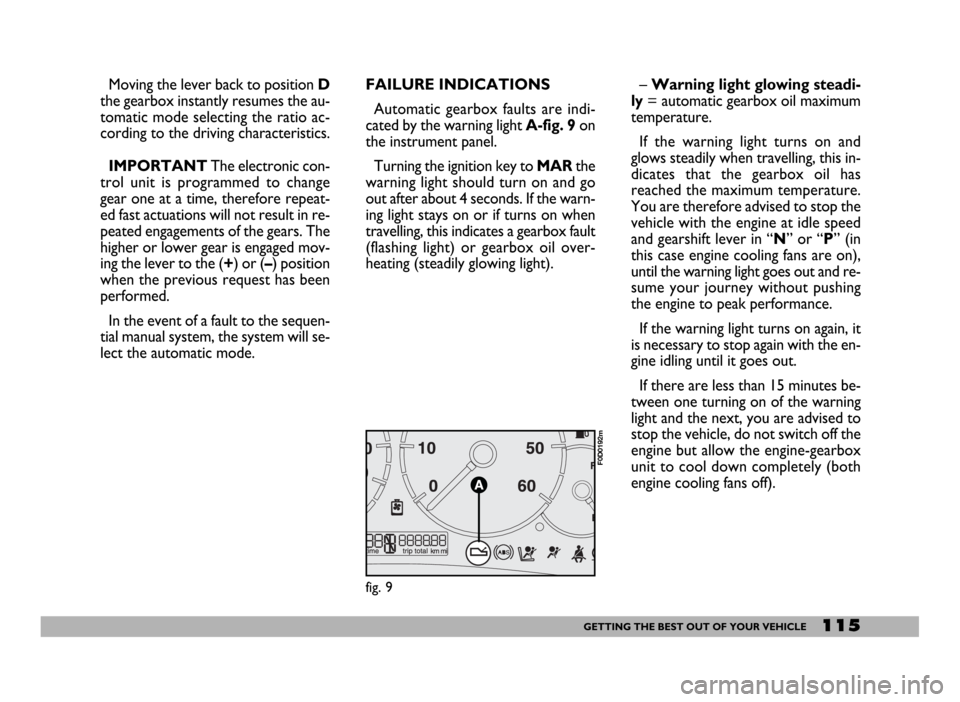
115GETTING THE BEST OUT OF YOUR VEHICLE
Moving the lever back to position D
the gearbox instantly resumes the au-
tomatic mode selecting the ratio ac-
cording to the driving characteristics.
IMPORTANTThe electronic con-
trol unit is programmed to change
gear one at a time, therefore repeat-
ed fast actuations will not result in re-
peated engagements of the gears. The
higher or lower gear is engaged mov-
ing the lever to the (+) or (–) position
when the previous request has been
performed.
In the event of a fault to the sequen-
tial manual system, the system will se-
lect the automatic mode.FAILURE INDICATIONS
Automatic gearbox faults are indi-
cated by the warning light A-fig. 9 on
the instrument panel.
Turning the ignition key to MARthe
warning light should turn on and go
out after about 4 seconds. If the warn-
ing light stays on or if turns on when
travelling, this indicates a gearbox fault
(flashing light) or gearbox oil over-
heating (steadily glowing light).– Warning light glowing steadi-
ly= automatic gearbox oil maximum
temperature.
If the warning light turns on and
glows steadily when travelling, this in-
dicates that the gearbox oil has
reached the maximum temperature.
You are therefore advised to stop the
vehicle with the engine at idle speed
and gearshift lever in “N” or “P” (in
this case engine cooling fans are on),
until the warning light goes out and re-
sume your journey without pushing
the engine to peak performance.
If the warning light turns on again, it
is necessary to stop again with the en-
gine idling until it goes out.
If there are less than 15 minutes be-
tween one turning on of the warning
light and the next, you are advised to
stop the vehicle, do not switch off the
engine but allow the engine-gearbox
unit to cool down completely (both
engine cooling fans off).
fig. 9
F0D0192m
Page 118 of 258

117GETTING THE BEST OUT OF YOUR VEHICLE
CONSTRUCTION FEATURES
DUCATO automatic gearbox is con-
trolled electronically with four for-
ward gears and reverse.
It is controlled by an electronic con-
trol unit which handles:
– the torque distributor;
– gearshifting;
– specific programmes.
The gearbox is coupled with a flow
power torque distributor with piloted
antislip device which makes it possible
to obtain demultiplication ratios.
The characteristic of this gearbox
which works without idle gear enables:
– higher compactness and weight re-
duction;
– improved output due to less fric-
tion;
– lower stress of transmission com-
ponents.GENERAL FEATURES
Electronic gearbox control makes it
possible to obtain gearshifting suited
to momentary engine characteristics
with a certain elasticity.
The electronic control unit has the
following task:
– adapting the oil pressure for
gearshifting to the engine torque;
– activating safety functions;
– defining the manual gearshifting
programme;
– system diagnostics.
For controlling these operating log-
ics the control unit uses the follow-
ing signals:
– engine rpm;
– engine temperature;
– engine torque;
– vehicle speed;
– gearbox oil temperature;– gearshift lever position;
– accelerator pedal position;
– brake pedal position.
The control unit also communicates
with the injection system electronic
control unit.
Conditions of use analysed by
the control unit
The control unit analyses each single
condition of use of the vehicle, dis-
criminating it on the basis of the sig-
nals received from the various sensors.
Analysed conditions are the follow-
ing:
– starting (position/accelerator ped-
al changing speed);
– acceleration (accelerator pedal
completely pushing down speed);
– full load (number of engine full load
kickdown signals or position mainte-
nance time);
Page 119 of 258

118GETTING THE BEST OUT OF YOUR VEHICLE
– braking (accelerator pedal release
time and braking system operation);
– type of programme (gearshift se-
lector lever position);
– winter driving (driving wheel
torque reduction);
– driving with trailer or uphill (vehi-
cle speed in relation to transmitted
torque)
– driving downhill (vehicle accelera-
tion in relation to the position of the
accelerator pedal);
– driving in towns or queues (accel-
erator pedal position and vehicle
speed);
– gear required by the driver
(gearshift lever position);
– cold starting (engine temperature).Gearshift programme control
To optimise vehicle handling the
electronic control unit has the fol-
lowing memorised programmes:
– automatic operation;
– manual operation;
– winter driving (to be selected
through buttonWINTER);
– engine warming up;
– protection against excessive gear-
box oil temperature .Automatic programme
This comprises 16 gearshifting pro-
grammes.
In relation to the vehicle speed and
torque transmitted, the control unit
detects the slope of the road surface
and depending on the sporty features
chosen, it autonomously chooses the
programme most suited to the situa-
tion.
During gearshifting, the gearbox con-
trol unit asks the injection control unit
to momentarily reduce the torque.
The duration of torque reduction
varies depending on the travelling con-
ditions.
Page 120 of 258

119GETTING THE BEST OUT OF YOUR VEHICLE
Manual sequential programme
This function enables manual se-
quential use of the gearbox merely
moving the selector lever to the left.
Each time the lever is pressed only
one gear is shifted: more than one shift
cannot be obtained.
To avoid overevving or excessively
low engine rpm, the control unit in-
hibits requests for gearshifting that
would cause such situations.
Winter driving programme
This programme is engaged by press-
ing button WINTERnear the
gearshift lever,
in case of driving wheel skidding and
it changes to specific gears.
Starting is possible only in 2
ndgear.
On snowy roads use however snow
chains and/or tyres.
The WINTERfunction shall always
be off on slopes.Engine warming up programme
This programme allows the engine to
reach normal operating temperature
in the shortest time possible (de-
pending on the outside temperature)
highering the gearshifting points, in re-
lation to engine temperature.
The programme engages automati-
cally after starting, if the engine tem-
perature is below 30 °C and it remains
active up to 34 °C.
Excessive gearbox oil
temperature programme
This is activated when the gearbox
oil temperature reaches 120 °C and it
remains active down to 117 °C.
To facilitate oil cooling, this pro-
gramme inhibits gearshifting, either up
or down. It is however possible to use
the manual programme.
SAFE DRIVING
In designing Ducato, Fiat has made
every effort to come up with a vehicle
able to provide driver and passengers
with top-class levels of safety. Never-
theless it is always the behaviour of the
person at the wheel that determines
road safety.
In the following pages you will find
some simple tips to help you travel in
safety under different conditions. You
will no doubt be familiar with many of
them already but it will be useful to
read them all carefully.